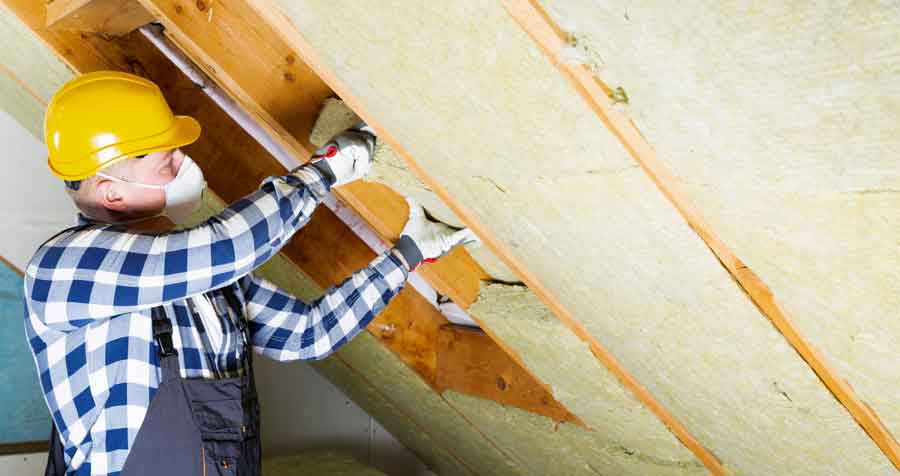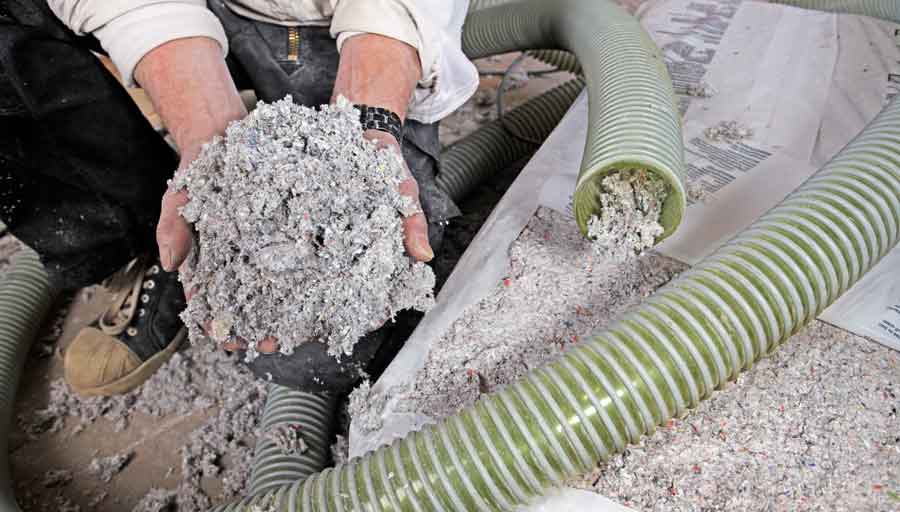There are two popular home and garage insulation types: batt insulation and blown insulation.
Both can effectively insulate your home from the elements, but one may be a better fit. You’ll need to consider your needs, home construction, and budget.
With so many options on the market, how can you decide which is right for you?
This article will cover the fundamental differences between batt vs blown insulation. We’ll discuss R-values, durability, cost, and the best use cases for each.
Batt vs. Blown Insulation: What’s the Difference?
As I said earlier, two of the most common types of insulation are batt insulation and blown insulation.
Batt insulation, often called blanket insulation, is packaged in thick, fluffy fiberglass rolls. These batts can be cut into different sizes to fit, no matter how long a space you’re insulating.
Alternately, batt insulation can come pre-cut to smaller lengths, in both 16″ and 24″ widths.
Batts usually have a foil or paper backing that acts as a radiant, moisture, or air barrier, depending on which backing is used.
It doesn’t require specialized equipment to install, but installers must use precise measurements to ensure complete coverage. Batt insulation is the most common insulation type.
There are two types of blown insulation: loose-fill and spray foam.
In both loose-fill and spray-foam insulation, there are additional subtypes based on what material they’re made from. For instance, loose-fill can be made of:
- Fiberglass
- Cellulose, which is usually made from recycled paper
- Mineral wool
- Polystyrene (styrofoam) beads
The two most common types of spray foam are open-cell and closed-cell foam.
Closed-cell foam looks like soap bubbles when it’s installed. The foam contains chemicals that close the foam cells and expand during installation.
Open-cell foam, on the other hand, only uses air for expansion. Both types require specialized equipment to install.
Each has different applications and different price points. However, both are regularly used in home construction and renovations.
What is R-Value?
When shopping for insulation, you’ll find the term ‘R-value.’
You’ll notice that higher R-values usually cost more than the same insulation with a lower R-value.
But what does that mean?
To answer that, we need to look at heat transfer. Heat moves from one place to another in one of three ways:
- Conduction (moving from one solid to another)
- Convection (moving through gases and liquids)
- Radiation (heat waves move in a straight line, being absorbed by anything in its path)
An insulation’s effectiveness is measured by its resistance against all three types of heat transfer. That measurement is called its R-value.
Contrary to popular belief, the R-value isn’t based on the thickness of the insulation material alone.
Almost every insulation material compresses as it settles over time. Since thickness isn’t consistent, R-values are calculated with a formula of thickness, material, density, age, and moisture absorption.
Generally, the higher an insulation’s R-value, the more effectively it will resist heat transfer, preventing heat loss in the winter and keeping spaces cool in the summer.
Batt vs Blown Insulation: Which is Better?
Believe it or not, a recent study found that all types of insulation (batt, loose-fill, or spray foam) perform almost identically.
That sounds counter-intuitive, but a variety of factors determine how effective your insulation will be.
For example:
- Installation quality
- Are there gaps in the coverage?
- How thick is the insulation?
- Moisture levels.
- Are there air gaps or pest damage?
- R-values of wall, floor, ceiling, and roofing materials, including:
- Wood frame
- Concrete foundation
- Wall and ceiling plaster or drywall
- Flooring materials
- Roof materials (plywood, sheathing, metal, shingles, or tiles)
Most importantly, are you using the correct product to meet specific building circumstances?
We’re always going to focus on the R-value. It’s an easy way to communicate how well insulation should work.
But even the most experienced insulation contractors can’t ensure a perfect, air-tight, or moisture-sealing solution. That means you should still choose the product with the highest R-value that you can reasonably afford.
Ultimately, the best product is the one that was installed the best.
Batt vs Blown Insulation: Cost
In general, batt insulation is cheaper to purchase and install than both blown-in or spray foam insulation.
Here’s a rundown of the costs of the insulation itself:
- Batt insulation: Approximately $0.30-$1.50 per square foot.
- Blown-in insulation: Approximately $1.00-$2.00 per square foot.
- Spray foam insulation: Approximately $0.50-$2.00 per square foot.
That doesn’t take into account the cost to install it, however.
Batt insulation can be a DIY project. In fact, I insulated my concrete garage walls with batt insulation by myself.
Both blown-in and spray-foam insulation require specialized equipment to install. You can rent this from hardware stores like Lowe’s or Home Depot. Still, having a professional contractor do it all is usually cheaper.
This means you’ll also have to factor in labor costs ranging from $ 0.25 to $0.50 per square foot.
That means that batt insulation easily wins the cost comparison.
If you’re on a budget, definitely go with batt insulation. Then, you can invest more of your budget into getting a higher R-value.
Batt vs Blown Insulation: Durability
According to the International Association of Certified Home Inspectors, all three insulation types (batt, loose-fill, and spray foam) have equal life spans.
In theory.
Insulation gradually compresses over time, losing its effectiveness. However, the insulation will likely last longer than you will, barring fire damage, moisture damage, or damage from pests or punctures.
Even though insulation is designed to last years, they’re not entirely element-proof.
Here are a couple of tips to make your insulation last as long as possible:
- Hire a high-quality installer or seek expert advice before DIY installation.
- Use the correct insulation product for the application location.
- Get rid of pests before installing insulation.
- Protect it from punctures or other damage during other home projects.
Batt vs. Blown Insulation: When to Use Each
It’s important to remember that an insulation contractor may recommend different products for each area of your home.
For example, an attic with several obstructions like air ducts or HVAC equipment would benefit from blown-in or spray foam insulation.
It’s easier to blow or spray insulation around obstacles than cutting batt insulation to fit around them.
Other spaces where spray foam or blown-in insulation would be ideal include:
- Attics with narrow spaces or steep roof pitches.
- Floor joist areas of existing, multi-story homes.
- Basements with obstructions like furnaces, other HVAC equipment, or structural elements.
When choosing a blown-in or spray foam insulation. Keep in mind the potential hazards of the room during an emergency.
For example, basements and garages are prone to flooding. Steer clear of open-cell spray foam products near the floor.
While closed-cell spray foam uses chemicals to expand the foam and prevent water absorption, open-cell foam only uses air for expansion, making it more susceptible to water damage.
Batts are useful in nearly every insulation application, including:
- Attics, walls, and floor joists of new construction homes.
- Homes with modern, smaller HVAC equipment.
- Homes with limited attic access.
No matter which type of insulation you choose for your home, remember that the most important thing is to install it correctly. That will make it as efficient and durable as possible.



